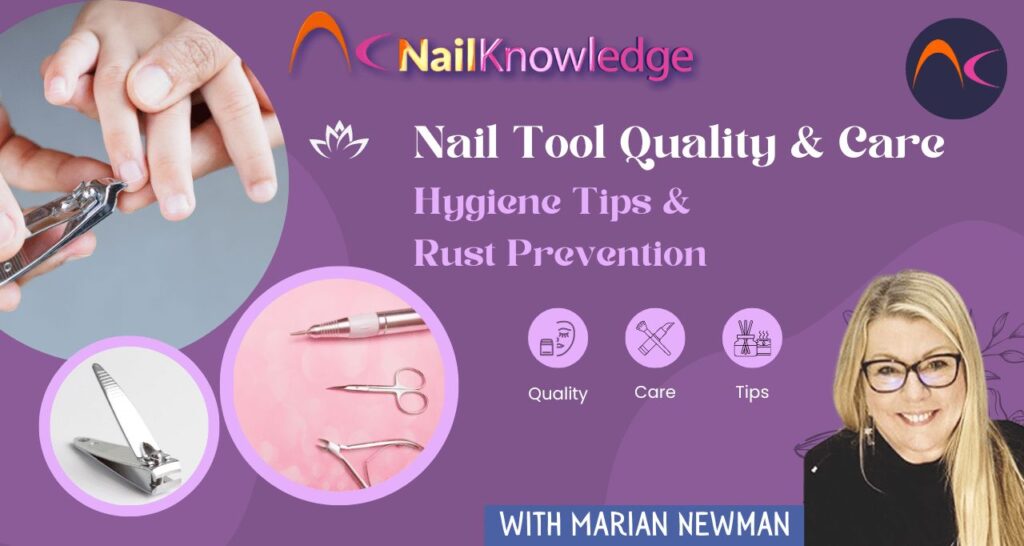There still seems to be a lot of confusion over the hygiene protocols of nail tools.
A recent blog ‘coated nail tools‘ was published, however, the blog I’m discussing here has a slightly different emphasis as it delves into the topic of tool quality and maintenance.
Understanding Stainless Steel Grades for Nail Tools
Stainless steel comes in various grades, and when it comes to nail tools, you want to focus on the ones that are also used in the food and medical fields. The top-notch choices are typically stainless steel grades 304 and 316. There’s another grade known as 420, which is sometimes claimed to have medical uses, but it’s generally of lower quality compared to the first two options.
The quality of steel will be reflected in the price an also if the tool is a unique shape. The majority are manufactured in Pakistan and China and are ‘off the shelf’. There are very few, if any new and unique designs in recent years..
Coated Nail Tools: Separating Fact from Cosmetic Claims
There is a trend for coated tools. This is a cosmetic reason and not much else. If any claims are made about products of any kind, we, as professionals, are perfectly entitled to ask for proof of the claim from an independent tester! Please remember this.
Question everything!!!
Doug Schoon wrote in a recent Blog about mixing products/brands in answer to those who say I’ve been mixing for years and had no problem: Who told you could and it is safe?? We are not scientists nor chemists we are nail professionals although rather too much science needs to be known and understood than many are comfortable with But that is the job and we deal with the public and their (and our) health and safety is our #1 priority!
Enhancing Nail Tool Longevity through Hygiene Protocols
On to hygiene protocols: we can all make our tools last longer by protecting their sharpness and keeping them free from damage and scratches.
Putting sharp edges in a glass container will blunt them. So will submerging them in a water based liquid for too long!
Any scratches in the metal will encourage corrosion i.e. rust. Be careful of tools that have a brand name etched on them as this is similar to scratches and can corrode if not looked after.
Most proprietary disinfectants are diluted with water which is known for causing corrosion in the wrong circumstances but it can be avoided.
The most important first step is to scrub every tool with soap and water, then submerge in correctly diluted disinfectant. Only leave it in there for the time instructed. Then remove them, rinse with water and dry. Then store them in a clean and closed container.
This is what most brands require but NB there may be differences in submersion time.
Wiping or spraying tools is NOT enough!! This does not clean the crevices in a hinge for example an etched surface or even where a coating has worn away. Spraying is only spraying a metal that will have skin or nail debris or oils and creams on it so will not reach the surface to do any geed at all. (same goes for files and buffers)
Above all, follow manufacturers instructions to the letter and if you are unsure ask them. All disinfectants should have an EN number to show what they have been tested against (see the chart in previous Blog) The Importance of Hygiene in the Nail Industry
There is no need for metal tools to rust if you follow instructions. Plus, there are ways of protecting coatings. A coated tool may look lovely when new but one that has areas of wear looks dirty!
There is no reason a water based disinfectant will harm your tools. Understand the steps and protocols and your investment will last you a long time.
It’s important to check if your supplier provides a sharpening service. If they do, your nail tools should return to you as sharp as they were when they were brand new, not just as dull as some people have experienced.
In Conclusion
When it comes to nail tool care, hygiene, and rust prevention, knowledge is your best tool. Understanding the different grades of stainless steel used in nail tools and selecting high-quality options can ensure longevity and performance. Beware of cosmetic trends like coated tools and always scrutinise product claims, demanding proof when necessary.
Hygiene protocols play a pivotal role in extending the life of your nail tools. Avoid practices that can dull or damage them and follow manufacturer instructions meticulously, including proper disinfection procedures. Remember that water-based disinfectants, when used correctly, are safe for your tools.
Finally, consider if your supplier offers a sharpening service, as this can rejuvenate your tools and maintain their sharpness over time. By following these guidelines and staying informed, you can ensure that your nail tools not only meet industry standards but also provide consistent and reliable performance throughout their lifespan.


